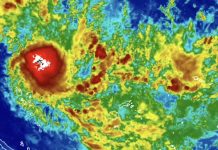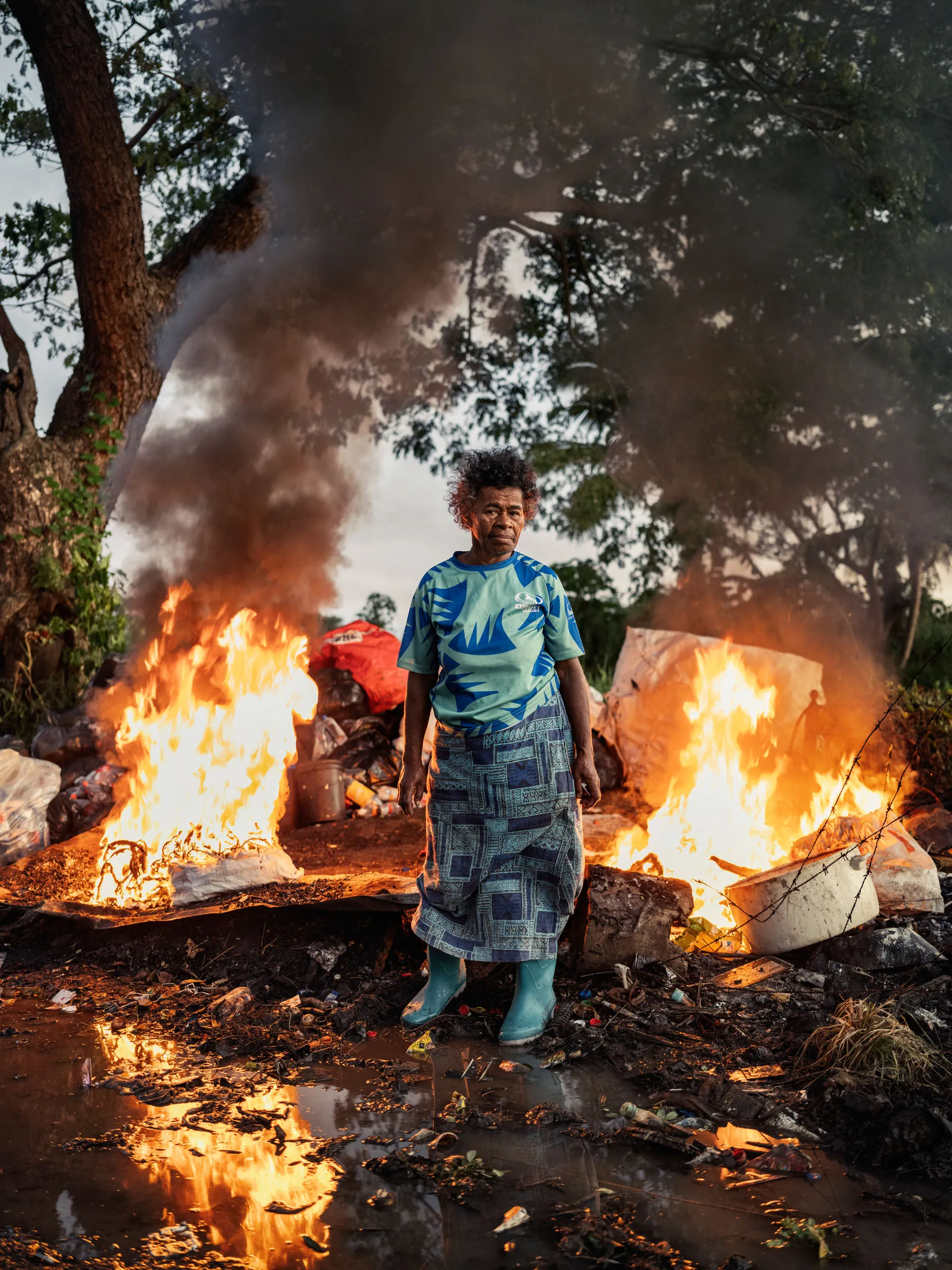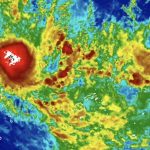With reporting by Lice Movono/Suva, Fiji, and Leslie Dickstein/New York
Whenever the growing pile of plastic waste in front of her door takes up too much space, Asinate Lewabeka has a simple solution. She sets it on fire. She prefers to do so at dawn when the air is still so that the smoke rises in a black column. She says any later in the day, the coastal breeze risks blowing the acrid fumes straight into her home, a modest shack built on the edge of the Vunato dump site in Lautoka, Fiji’s second largest city.
Lewabeka watches in satisfaction as flames consume the haphazard pile of empty water bottles, travel-size tubes of shampoo, juice cartons, wads of food packaging, a broken plastic fan, and coils of copper wire coated in PVC insulation, reducing it all to carbonized lumps. “Plastic rubbish is the worst kind,” she says. “It is everywhere. It makes our country look so bad. I don’t want it to be a pollutant in our neighborhood, so I collect it and burn it so I can get rid of it.”
It may no longer be an eyesore, but Lewabeka’s problem is far from gone. Burning plastic releases toxic substances that will remain in the environment for hundreds of years, with deleterious impacts on human and ecosystem health. Yet open burning is one of the most common methods for eliminating unwanted waste in a remote island nation besieged by a plastic tide. Less than a third of Fiji’s plastic waste is locally produced. The rest drifts in with ocean currents from as far away as South Africa and Mexico. It must be disposed of, wherever it comes from, and burning is often the simplest option.
After the final embers of Lewabeka’s bonfire flicker out, the smoke sinks into a choking haze that irritates the eyes as it ripples through the community. Small breezes kick up the ashes, coating in an oily soot the chassis of a long-abandoned car that has become a playground for the neighborhood children. The afternoon rains sweep the partially burnt remains into a nearby stream that irrigates several modest vegetable plots before emptying into the bay. When washed into the ocean, what’s left of the plastic detritus will break into microscopic particles that leach heavy metals and toxic chemicals into the marine environment, slowly poisoning the fish that residents reel in for their evening meals.
Lewabeka’s bonfire is replicated dozens of times daily in communities around the world, and across the Fijian archipelago, creating a toxic burden on human and environmental health that is only starting to be quantified.
The evidence, however, is already apparent: microplastics found in the flesh of almost every marine species tested; certain plastic chemicals identified in drinking water; others in the leaves of plants irrigated by polluted streams. And while Fiji’s high rates of cancer and diabetes have not been scientifically linked to the presence of plastic in the environment, there is research elsewhere suggesting that it might yet be the case. “The data is building that plastics have the potential to adversely impact human health,” says Linda S. Birnbaum, a toxicologist and the former director of the National Institute of Environmental Health Sciences in the U.S. “Burning plastic waste releases dioxins that stay in the environment forever and are linked to cancers as well as reproductive and developmental impairments. We know plastics are a problem; we know we’ve contaminated our world.”
Humans have produced more than 11 billion metric tons of virgin plastic since 1950, when plastic first came into widespread use, according to Roland Geyer, lead author of one of the first scientific studies quantifying the global plastic habit. According to his research, only 2 billion metric tons are still in use today, meaning the rest—some 8.7 billion tons—is waste. According to the UN Environment Programme, the world produces 430 million metric tons of plastic annually, two-thirds of which are short-lived products destined for disposal.
When researchers revealed the extent of the world’s plastic pollution crisis nearly a decade ago, they spread the word with evidence that packed a visual punch: dolphins entangled in plastic bags, a viral video of a straw being removed from a turtle’s nose. The chemicals that go into plastic production, which are emitted when it breaks down, are harder to see, but they carry a far more pernicious threat to human life.
Cleaning up that pollution is all but impossible, and so a global movement is under way to stop production at the source. Fiji is leading the charge, championing a robust global treaty as countries around the world convene this year in a series of dedicated U.N.-sponsored meetings that will conclude in South Korea in November. Fiji, along with other so-called high ambition nations, wants to see the Intergovernmental Negotiating Committee on Plastic Pollution (INC) produce a treaty that will substantially reduce the production of unessential plastics, minimize plastic’s chemical load, and hold manufacturers responsible for the sustainable disposal of their products.
Depending on how it is interpreted, such a treaty could deal a blow to the country’s biggest export: Fiji Water. The premium bottled water company produces, fills, and exports more than half a billion of its iconic square plastic bottles every year. Fiji Water, owned by the California-based Wonderful Co., is one of Fiji’s’s biggest employers, its largest single taxpayer, and a primary foreign-exchange earner. Few would argue that the pricey bottled water, quaffed by celebrities and wealthy Westerners, constitutes an essential use of plastic. But for Fiji, it’s an important financial driver.
Fiji’s struggle to balance an economic need for plastic production with a public health plea for its reduction illustrates a complex relationship with a product that has become the cornerstone of modern life. Fiji Water’s appeal comes, in part, from the perception that its source is a paradisiacal land of pure waters, yet the very vehicle of that bottled dream is a global pollutant, says Rufino Varea, a Fijian environmental toxicologist and a member of Fiji’s delegation to the treaty negotiations. “I know that it is a company that provides jobs to many Fijians. And we can see that the business is important to a country like ours.” But knowing the impacts of plastic pollution, he says that as a Fijian, he feels uncomfortable contributing to the cycle. “This plastic-water-bottle thing has to stop.”
Fiji has more than 330 islands, one sanitary landfill, and two municipal dumps. While some high-end resorts ship their plastic waste back to the main island for disposal, few communities can afford to do the same. As a result, most of Fiji’s plastic waste is burned, buried, or tossed into the environment.
Rising sea levels and heavy rainfall sweep the dumped refuse out to sea, where it joins plastic refuse drifting in from other regions and is swept back to shore by circulating ocean currents. There, it is collected in cleanup campaigns conducted by a hospitality industry eager to keep the beaches pristine for tourists—the mainstay of the Fijian economy. And so, the cycle continues. Burning is seen as the best option for stopping the endless return of a product that, while considered disposable, seems to last forever.
“It’s just people trying to clean up their waste without realizing the damage that can be done,” says Dr. Ane Veu, Fiji’s leading oncologist. She understands the impetus to burn waste but worries that the invisible pollutants are taking a toll. Veu has seen firsthand how cancer cases, even once rare lymphomas and leukemias, have more than doubled over the past decade; rates of asthma and metabolic disease are also rising. While some of those numbers can be attributed to increasingly sedentary lifestyles, diet, and better monitoring, she suspects that increasing exposure to plastics plays a role. If research were formally undertaken in Fiji, as has been done elsewhere in the world, she believes it would likely “show that yes, there is a direct link between [plastic pollution] and the rising number of cancers.”
She is not alone. A growing body of evidence is linking plastics to adverse human health outcomes. Scientific research has long demonstrated that burning plastic emits toxic and carcinogenic gases. More recent studies show that micro- and nanoplastics—tiny particles produced when plastic breaks down—can be found everywhere on the planet and almost everywhere in the human body, from blood to breast milk.
Scientific research on the effects of those microplastics in the human body is limited, at least in peer-reviewed literature. Still, the cumulative evidence is enough to raise an alarm, says Dr Philip Landrigan, a professor at Boston College and the director of its Programme for Global Public Health and the Common Good. He cites a recent study published in the New England Journal of Medicine that found particles of polyethylene (used to make plastic bags and bottles) lodged in the arterial plaque of 150 out of 304 patients participating in a cardiovascular study, correlating with a 4.5-fold increase in risk of heart attack, stroke, or death in those patients— “nearly on par with smoking a pack a day,” he says. Another study in mice demonstrated that ingested particles can cross the blood-brain barrier, leading to behavioural changes similar to human dementia.
Most plastics are derived from crude oil, methane gas, or coal. Chemicals are added to create different characteristics, such as flexibility or water repellency. In March, a team of European scientists published a database of more than 16,000 chemicals found in plastics, only a quarter of which have been tested for health impacts. Almost all of those were found to be hazardous to human health, with links to inflammatory bowel disease, cancer, autism, and ADHD. PFAS—per- and polyfluoroalkyl substances that are often added for water resistance—disrupt the endocrine system with impacts on fertility, immunity, development, and increased risks of developing Type 2 diabetes.
Geyer says that he wouldn’t be surprised if “a couple of decades from now, researchers look back at us and say, ‘They were so naive. There was this huge uptick in neurological problems, in cancer, autism, ADHD, and whatnot. At the same time, everyone was using these crazy pollutants they didn’t understand and knew nothing about … How could they not put one and one together?’”
Varea, a PhD candidate studying plastic pollution at Fiji’s University of the South Pacific, is from the northernmost island of Rotuma, a remote, palm-fringed paradise that, like every other paradise in the archipelago, is choked with plastic that has washed up on shore. Varea’s research focuses on testing soil, water, shellfish, and fish samples from Fiji’s coastal areas for microplastics. A “very high percentage” come up positive, he says. That is a concern for a nation where 60 percent of the population depends on the ocean for food. The most frustrating part, he says, is that most of the waste comes from somewhere else.
According to Eric Chassignet, an oceanographer with the Centre for Ocean Atmospheric Prediction Studies at Florida State University who models plastic waste flows on global ocean currents, only 28 percent of the plastic waste on Fiji’s shores comes from Fiji. A quarter comes from regional neighbors, and most of the rest comes from Latin America. As with the countries that suffer the most from climate change, while contributing the least, Fiji can’t do much to stop the plastic tide. All it can do is clean up the mess. “We’re doing what we can,” says Varea. “But it needs to be a global effort, and most of this effort must come from plastic-producing countries.”
Like most Pacific Island nations with limited land and small economies, Fiji cannot even handle its own plastic waste, let alone an influx from other countries. Only about a third of the population, concentrated in the urban areas on the main island, has access to garbage collection. That leaves residents and resort owners everywhere else to fend for themselves. A 2021 report commissioned by the International Union for Conservation of Nature estimates that a quarter of the country’s plastic waste is mismanaged—either thrown into rivers or straight into the ocean. Either way, it eventually ends up back on shore.
Shore cleanups can help reduce the plastic plague. However, local community organisations, international conservation groups, and resorts seeking to maintain their postcard-perfect beaches face the same conundrum: What should be done with plastic waste once it is collected? In some countries, it can be transported to recycling facilities on the mainland via boat. That’s impractical, and expensive, for a nation comprising hundreds of islands scattered over more than 500,000 sq. mi. For some communities, the nearest landfill is more than a day’s boat journey away.
The thousands of small waste fires lit daily across Fiji are a sign that plastic pollution is beyond the country’s ability to manage it, says Peter Thomson, a Fijian diplomat and the UN Secretary-General’s Special Envoy for the Ocean. “Nowadays, everything comes in plastic. And as we know, it doesn’t degrade. So, what do you do with all that plastic? It’s a huge problem for an island economy.” He means that quite literally: for some island nations he has visited, landfills are the highest elevation. “The fact is, we just have to change the global plastic system.”

Designed to last forever but cheap enough to be thrown away, plastic has become an industry worth US$712 billion a year, with no signs of slowing down. The world is producing four times as much plastic as it did in the 1990s, and consumption—along with waste—is expected to nearly triple by 2060, according to the Organisation for Economic Cooperation and Development. That is by design.
The International Energy Agency (IEA) projects that demand for fossil fuels will peak before the end of this decade as the world moves toward renewable energy. That makes plastic, which is derived from fossil fuels, a lifeline for an industry facing global efforts to transition away from oil and gas to combat climate change. Last year, Sultan Al Jaber, head of the Abu Dhabi National Oil Company, told the Guardian that if the company’s expanded production capacity of 600,000 barrels a day were not needed in a renewables-fueled world, those hydrocarbons could be turned into plastics instead. “Everything around us is made from this finite resource. We have to accept that.”
Not everyone does. To reduce the impact of what is rapidly becoming the planet’s most ubiquitous manufactured material, 175 nations agreed in March 2022 to draft a legally binding treaty to end plastic pollution on land and in the marine environment. The first four phases of negotiations have produced a draft, but negotiators are still divided over the treaty’s scope: fossil-fuel-producing nations, including the U.S., say the solution to plastic pollution lies in tackling the mess through better recycling and cleanup efforts. But recycling is, at best, a stopgap measure—less than 10 percent of the world’s plastic is currently recycled—and at worst a well-orchestrated public-relations campaign designed to put the onus of plastic’s toll on consumers and communities, rather than producers.
The 127 nations that make up the High Ambition Coalition—of which Fiji is a member, along with the E.U., most of Africa, Japan, Canada, Mexico, and Australia, among others—are asking for restrictions on the use of chemicals in plastic formulations, limits on plastic production, a plastic tax, and bans on nonessential products like single-use items.
A strong treaty would curb the plastic flood by stopping it at the source, say proponents. A weak one focused on cleanup would be like bailing out an overflowing bathtub before turning off the tap.
“Everybody’s heard about how there’s going to be more plastic than fish in the ocean by 2050 if we carry on with our current course,” says Thomson. “The motivation of the plastic treaty is to make sure that does not happen.” More important, he says, is a treaty prioritizing human health, with wording in the text that outlaws harmful chemicals. “My prediction is that in 10 to 20 years’ time, we will be in the position we were in with the tobacco companies a few decades ago, where countries are starting to legislate against plastics [because of the public health impact].”
The best way to reduce production is to start with figuring out what is, and is not, essential, says Bethanie Carney Almroth, a professor of ecotoxicology at Sweden’s University of Gothenburg and a member of the Scientists’ Coalition for an Effective Plastics Treaty, which advocates for a negotiation process informed by science. Medical equipment, like blood bags and flexible tubing, is vital. Disposable plastic forks, less so. The treaty, she says, needs to be flexible enough to adapt to a changing world. “If something is identified as essential right now, but still problematic, then that should trigger mechanisms to solve the problem and make that product obsolete.”
Eliminating disposable plastics would go a long way toward improving health, says waste-management expert Costas Velis at the University of Leeds. He estimates that some 2 billion people worldwide lack dedicated garbage collection services. If space is limited, and there are no nearby rivers for dumping, many will resort to burning, in what he calls an overlooked health crisis. His research estimates that some 270,000 premature deaths result from the open burning of waste every year around the world. “Open, uncontrolled burning of anything is bad enough for the health, but open burning of plastics, with all their unknown chemistry, is possibly orders of magnitudes worse.”

In 2020, to manage its own pollution problem, Fiji implemented a ban on single-use plastics. Water bottles were notably exempted, mainly because access to clean drinking water is limited outside the main cities. But also because banning bottles would be impractical for a country that exports them. Fiji Water directly employs some 800 Fijians; 300 suppliers employ hundreds more. The company also sponsors the national rugby team, and its philanthropic arm, the Fiji Water Foundation, spent US$1.5 million last year on health, development, and education projects within the country. That doesn’t mean the company should get a free pass, says Varea, the Fijian ecotoxicologist. “We need to weigh job creation and investment against waste production and management. Corporations that are involved in plastic packaging, including bottled water, need to have more accountability.”
Fiji Water argues that from a sustainability point of view, plastic bottles made from polyethylene terephthalate, or PET, are less carbon intensive when it comes to production and transportation than aluminum or glass. (This assessment is based on a study commissioned by the National Association for PET Container Resources). The company already uses recycled PET plastic in 70 percent of its bottles, and by 2025, it says, all bottles will be made from RePET. It also supports a bottle-buyback scheme with Coca-Cola in three main island cities, paying 5 Fijian cents (US$0.02) per bottle. “Frankly, nobody else in Fiji is doing as much as Fiji Water” in terms of managing their plastic footprint, says Ashneel Naidu, the director of plant operations. “Why should we, a developing island country, give up something that’s so important to us? Why can’t people in developed countries turn their lights off for a few minutes? Wouldn’t that have a bigger impact [on the planet] than us giving up one of our most economically important drivers?”
Sivendra Michael, Fiji’s Permanent Secretary for the Ministry of Environment and Climate Change and one of the lead voices calling for a robust plastics treaty at the INC negotiations, recognises that plastics have a role to play in the economic development of many of the countries that suffer most from its pollution, including his own. Bans on nonessential plastics with easy alternatives makes sense, he says. Replacing Fiji Water’s plastic bottle exports with glass may not. In cases where plastic alternatives are out of reach, another approach is needed: making manufacturers responsible for their products through the end of life, instead of just to the point of sale.
That is what Fiji Water is already doing, on a limited basis, with its bottle-buyback programme. On a recent Wednesday, Lewabeka returned from the bottle-buyback centre to her modest shack near the Vunato dumpsite with FJD$300 (US$133), proceeds earned from a few days’ worth of sorting through the trash to find recyclables. When she started as a waste picker 27 years ago, glass bottles and aluminum cans were her primary source of income. Now, it’s plastic bottles, but only ones from Fiji Water, Coca-Cola, and local drinks producer Sprint. None of the other companies pay for returns. “I will take what I am paid to take,” Lewabeka, 64, says, hovering with her lighter next to a pile of plastic bottles from other brands. “Those people really should be paying for us to bring in their bottles too, because it’s their bottles you see the most.” She estimates that for every bag of Fiji, Coke, and Sprint bottles she takes in for recycling, she will burn another pile of trash at home.
Lewabeka’s bottles won’t be recycled at the buyback centre. Instead, they will be shredded, packed into pallets, and shipped to Australia, where they will be melted down and turned into RePET pellets, ready to feed the global demand for recycled plastic in new products. It would be better, of course, if Fiji Water could close the loop by using its own bottles (or others) to create new ones, but there is no recycling facility in Fiji. Meanwhile, the cost of shipping a ton of plastic abroad for processing far outweighs the price per ton of recycled PET on the market.
Only 23 percent of Fiji Water bottles are returned in Fiji. It’s an abysmal rate, but still better than the global plastic-recycling average, and a model for how the country could start getting on top of its plastic-pollution problem—especially if it’s implemented across all brands. Fiji Water’s voluntary programme is a precursor to a countrywide bottle-deposit scheme under parliamentary review. Kinks are still being worked out: 5 Fiji cents might be enough incentive for residents to return bottles if they live near collection centres, but probably not enough for remote island communities to bring their plastics to a centralized location. The alternative would be to build collection points on each island, managed by a regional waste-collection system—a costly investment.
If recycled plastic, like aluminum or glass, had a high enough value, a recycling system would pay for itself. The problem is that virgin plastic is cheap and abundant, so manufacturers have little incentive to opt for higher-cost recycled materials. One of the more contentious items supported by Fiji in the INC draft treaty to be finalised in November seeks to change that metric by proposing a per-ton tax on virgin plastic. Such a fee, paid by producers, manufacturers, or importers, would be used to fund waste-collection systems and recycling infrastructure in areas that need it most. It would, essentially, encourage producers to use less virgin plastic, while taking responsibility for their products.
For Lewabeka, it seems like an obvious solution. “The companies that are making this stuff should be paying to clean it up,” she says as she sweeps a pile of ashes away from her front door. “If everything had a value, then I wouldn’t have anything left to burn.
This story was reported with support from the Pulitzer Centre Ocean Reporting Network.















